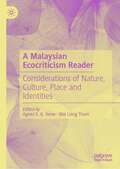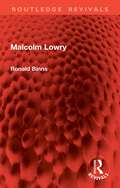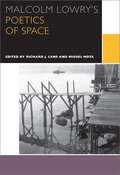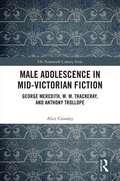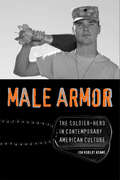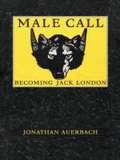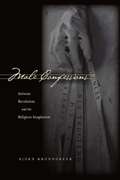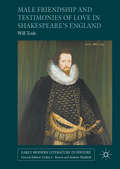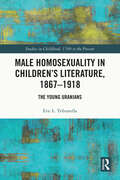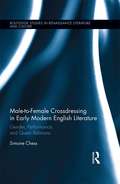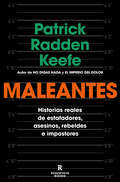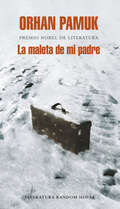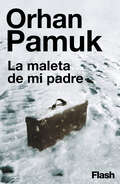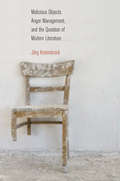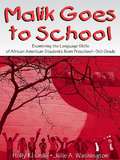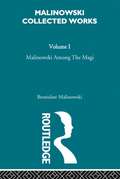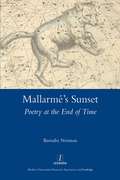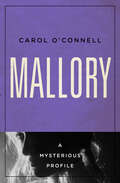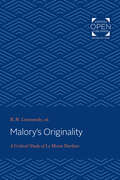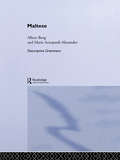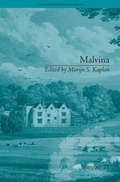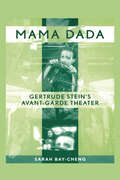- Table View
- List View
A Malaysian Ecocriticism Reader: Considerations of Nature, Culture, Place and Identities
by Agnes S. K. Yeow Wai Liang ThamThis collection of essays brings together ecocritical interpretations of Malaysian texts – including fiction, nonfiction, and other media / cultural expressions. It includes original works by environmental activists as well as emerging and established scholars, who collectively analyse various aspects of Malaysian ecological discourse.The contributors address crucial – and often controversial – topics such as local ecological imaginations, wildlife conservation, overdevelopment, postcolonial ecological identities, biopolitics, nature and sexuality, nature and race, the commodification of nature, nature–culture embodiments and entanglements, human–animal relations, waste and materiality, human and other-than-human agency, toxicity and slow violence, self-representations as well as attitudes towards land, nativity and indigeneity, migrancy and diaspora.Readers will gain valuable insights into the ways in which environments and ecological relationships are mediated within this national space, while opening up room to theorise beyond its boundaries.
Malcolm Lowry (Routledge Revivals)
by Ronald BinnsMalcolm Lowry’s Under the Volcano is now recognized as one of the major novels of the 20th Century, whose breadth and experimental prose have influenced a wide range of contemporary writers. This study, originally published in 1984, considers the significance of the autobiographical elements in Lowry’s writing, in the context of his developing concern with fictionality and the romantic sensibility. It gives special attention to his exotic many-sided masterpiece and discusses the ways in which the narrative’s reflexive games-playing elements affect the representation of character, history, myth and magic. It surveys Lowry’s late experimental novels and stories and considers how their metafictional aspects anticipate some key interests of contemporary writing.
Malcolm Lowry's Poetics of Space (Canadian Literature Collection)
by Richard J. Lane and Miguel MotaThis collection focuses on Lowry’s spatial dynamics, from the psychogeography of the Letterist and the Situationist International, through musical forms (especially jazz), cinema, photography, and spatial poetic writing, to the spaces of exception, bio-politics, and the creaturely. It presents previously unpublished essays by both established and new international Lowry scholars, as well as innovative ways of conceiving of his aesthetic practice. In each of the book’s three sections, critics engage in the notion of Lowry as a multi-media artist who influenced and was deeply influenced by a broad range of modernist and early postmodernist aesthetic practices. Acutely aware of and engaged in the world of film, sensitive to the role of the graphical surface in advertising and propaganda, and deeply immersed in a vast range of literary traditions and the avant-garde, Lowry worked within an intertextual space that is also a mediascape, one which tends to transgress, or at least exceed, neatly controlled borders or aesthetic boundaries. These new approaches to Lowry’s life and work, which make use of new and recent theoretical perspectives, will encourage fresh debate around Lowry’s writing. Publié en anglais.
Male Adolescence in Mid-Victorian Fiction: George Meredith, W. M. Thackeray, and Anthony Trollope (The Nineteenth Century Series)
by Alice CrossleyFocusing on works by George Meredith, W. M. Thackeray, and Anthony Trollope, Alice Crossley examines the emergence of adolescence in the mid-Victorian period as a distinct form of experience. Adolescence, Crossley shows, appears as a discrete category of identity that draws on but is nonetheless distinguishable from other masculine types. Important more as a stage of psychological awareness and maturation than as a period of biological youth, Crossley argues that the plasticity of male adolescence provides Meredith, Thackeray, and Trollope with opportunities for self-reflection and social criticism while also working as a paradigm for narrative and imaginative inquiry about motivation, egotism, emotional and physical relationships, and the possibilities of self-creation. Adolescence emerges as a crucial stage of individual growth, adopted by these authors in order to reflect more fully on cultural and personal anxieties about manliness. The centrality of male youth in these authors’ novels, Crossley demonstrates, repositions age-consciousness as an integral part of nineteenth-century debates about masculine heterogeneity.
Male Armor: The Soldier-hero in Contemporary American Culture (Cultural Frames, Framing Culture)
by Jon Robert AdamsThere is no shortage of iconic masculine imagery of the soldier in American film and literature--one only has to think of George C. Scott as Patton in front of a giant American flag, Sylvester Stallone as Rambo, or Burt Lancaster rolling around in the surf in From Here to Eternity. In Male Armor, Jon Robert Adams examines the ways in which novels, plays, and films about America's late-twentieth-century wars reflect altering perceptions of masculinity in the culture at large. He highlights the gap between the cultural conception of masculinity and the individual experience of it, and exposes the myth of war as an experience that verifies manhood.Drawing on a wide range of work, from the war novels of Ernest Hemingway, Norman Mailer, James Jones, and Joseph Heller to David Rabe's play Streamers and Anthony Swofford's Jarhead, Adams examines the evolving image of the soldier from World War I to Operation Desert Storm. In discussing these changing perceptions of masculinity, he reveals how works about war in the late twentieth century attempt to eradicate inconsistencies among American civilian conceptions of war, the military's expectations of the soldier, and the soldier's experience of combat. Adams argues that these inconsistencies are largely responsible not only for continuing support of the war enterprise but also for the soldiers' difficulty in reintegration to civilian society upon their return. He intends Male Armor to provide a corrective to the public's continued investment in the war enterprise as a guarantor both of masculinity and, by extension, of the nation.
Male Call: Becoming Jack London
by Jonathan AuerbachWhen Jack London died in 1916 at age forty, he was one of the most famous writers of his time. Eighty years later he remains one of the most widely read American authors in the world. The first major critical study of London to appear in a decade, Male Call analyzes the nature of his appeal by closely examining how the struggling young writer sought to promote himself in his early work as a sympathetic, romantic man of letters whose charismatic masculinity could carry more significance than his words themselves.Jonathan Auerbach shows that London's personal identity was not a basis of his literary success, but rather a consequence of it. Unlike previous studies of London that are driven by the author's biography, Male Call examines how London carefully invented a trademark "self" in order to gain access to a rapidly expanding popular magazine and book market that craved authenticity, celebrity, power, and personality. Auerbach demonstrates that only one fact of London's life truly shaped his art: his passionate desire to become a successful author. Whether imagining himself in stories and novels as a white man on trail in the Yukon, a sled dog, a tramp, or a professor; or engaging questions of manhood and mastery in terms of work, race, politics, class, or sexuality, London created a public persona for the purpose of exploiting the conventions of the publishing world and marketplace.Revising critical commonplaces about both Jack London's work and the meaning of "nature" within literary naturalism and turn-of-the-century ideologies of masculinity, Auerbach's analysis intriguingly complicates our view of London and sheds light on our own postmodern preoccupation with celebrity. Male Call will attract readers with an interest in American studies, American literature, gender studies, and cultural studies.
Male Confessions: Intimate Revelations and the Religious Imagination
by Björn KrondorferMale Confessions examines how men open their intimate lives and thoughts to the public through confessional writing. This book examines writings--by St. Augustine, a Jewish ghetto policeman, an imprisoned Nazi perpetrator, and a gay American theologian--that reflect sincere attempts at introspective and retrospective self-investigation, often triggered by some wounding or rupture and followed by a transformative experience. Krondorfer takes seriously the vulnerability exposed in male self-disclosure while offering a critique of the religious and gendered rhetoric employed in such discourse. The religious imagination, he argues, allows men to talk about their intimate, flawed, and sinful selves without having to condemn themselves or to fear self-erasure. Herein lies the greatest promise of these confessions: by baring their souls to judgment, these writers may also transcend their self-imprisonment.
Male Friendship and Testimonies of Love in Shakespeare's England
by Will ToshMale Friendship and Testimonies of Love in Shakespeare's England reveals the complex and unfamiliar forms of friendship that existed between men in the late sixteenth century. Using the unpublished letter archive of the Elizabethan spy Anthony Bacon (1558-1601), it shows how Bacon negotiated a path through life that relied on the support of his friends, rather than the advantages and status that came with marriage. Through a set of case-studies focusing on the Inns of Court, the prison, the aristocratic great house and the spiritual connection between young and ardent Protestants, this book argues that the 'friendship spaces' of early modern England permitted the expression of male same-sex intimacy to a greater extent than has previously been acknowledged.
Male Homosexuality in Children’s Literature, 1867–1918: The Young Uranians (Studies in Childhood, 1700 to the Present)
by Eric L. TribunellaIn his 1908 cultural and historical study of homosexuality titled The Intersexes: A History of Similisexualism as a Problem in Social Life (1908), Edward Irenæus Prime-Stevenson includes a section on homosexual juvenile fiction, perhaps the first attempt to identify a body of children’s literature about male homosexuality in English. Known for pioneering the explicitly gay American novel for adults, Stevenson was also one of the first thinkers to take seriously the possibility and value of homosexual children, whom he called "young Uranians." This book takes as its starting point Stevenson’s catalog of homosexual boy books around the turn of the century and offers a critical examination of these works, along with others by gay writers who wrote for children from the mid-nineteenth century through the end of World War I. Stevenson’s list includes Eduard Bertz, Howard Sturgis, Horace Vachell, and Stevenson himself—to which Horatio Alger, John Gambril Nicholson, and E.F. Benson are added. Read alongside major developments in English- and German-language sexology, these boy books can be understood as participating in the construction and dissemination of the discourse of sexuality and as constituting the figure of the young Uranian as central to modern gay identity.
Male Homosexuality in Children’s Literature, 1867–1918: The Young Uranians (ISSN)
by Eric L. TribunellaIn his 1908 cultural and historical study of homosexuality titled The Intersexes: A History of Similisexualism as a Problem in Social Life, Edward Irenæus Prime-Stevenson includes a section on homosexual juvenile fiction, perhaps the first attempt to identify a body of children’s literature about male homosexuality in English. Known for pioneering the explicitly gay American novel for adults, Stevenson was also one of the first thinkers to take seriously the possibility and value of homosexual children, whom he called "young Uranians." This book takes as its starting point Stevenson’s catalog of homosexual boy books around the turn of the century and offers a critical examination of these works, along with others by gay writers who wrote for children from the mid-nineteenth century through the end of World War I. Stevenson’s list includes Eduard Bertz, Howard Sturgis, Horace Vachell, and Stevenson himself—to which Horatio Alger, John Gambril Nicholson, and E.F. Benson are added. Read alongside major developments in English- and German-language sexology, these boy books can be understood as participating in the construction and dissemination of the discourse of sexuality and as constituting the figure of the young Uranian as central to modern gay identity.
Male-to-Female Crossdressing in Early Modern English Literature: Gender, Performance, and Queer Relations (Routledge Studies in Renaissance Literature and Culture)
by Simone ChessThis volume examines and theorizes the oft-ignored phenomenon of male-to-female (MTF) crossdressing in early modern drama, prose, and poetry, inviting MTF crossdressing episodes to take a fuller place alongside instances of female-to-male crossdressing and boy actors’ crossdressing, which have long held the spotlight in early modern gender studies. The author argues that MTF crossdressing episodes are especially rich sources for socially-oriented readings of queer gender—that crossdressers’ genders are constructed and represented in relation to romantic partners, communities, and broader social structures like marriage, economy, and sexuality. Further, she argues that these relational representations show that the crossdresser and his/her allies often benefit financially, socially, and erotically from his/her queer gender presentation, a corrective to the dominant idea that queer gender has always been associated with shame, containment, and correction. By attending to these relational and beneficial representations of MTF crossdressers in early modern literature, the volume helps to make a larger space for queer, genderqueer, male-bodied and queer-feminine representations in our conversations about early modern gender and sexuality.
Maleantes: Historias reales de estafadores, asesinos, rebeldes e impostores
by Patrick Radden KeefeTras No digas nada y El imperio del dolor, Patrick Radden Keefe explora los límites, a menudo imperceptibles, entre lo legal y lo ilegal, a través de doce retratos reales protagonizados por maleantes de medio mundo LIBRO DE LA SEMANA POR EL PERIÓDICO «Keefe hahecho carrera sumergiéndose en personajes fascinantes, en eso es el mejor. [...] En Maleantes regresa con su altísimo rigor periodístico y la misma pasión de siempre por desvelar misterios, con un resultado inconfundible».New York Times Book Review «Un narrador virtuoso».The Washington PostCon el fascinante estilo que le caracteriza, Patrick Radden Keefe ofrece en este libro una compleja panorámica del lado oscuro del ser humano. Aquí retrata, entre otros personajes, al traficante de armas Monzer al-Kassar, apodado «el príncipe de Marbella» y perseguido incansablemente por un agente de la D.E.A., a la controvertida «abogada del diablo» que lucha contra la pena de muerte representando a los peores criminales, al Chapo Guzmán y su vida tras huir de una prisión de alta seguridad, o al célebre delincuente holandés William Holleeder y los esfuerzos de su propia hermana para lograr su encarcelación. Maleantes recoge doce perfiles de estafadores, truhanes, asesinos y rebeldes, gente que nada a contracorriente y cuya vida excepcional, para bien y para mal, invita al lector a reflexionar sobre temas como la esencia del mal, del poder, del crimen y de la corrupción, pero también sobre el coraje de quienes decidieron enfrentarse a ellos. La crítica ha dicho... «Una obra rigurosa y literaria. [...] Honesto y escrupuloso, [Radden Keefe] es la cara y la cruz del periodismo».Marta Ailouti, El Cultural «Lo ha vuelto a hacer. Una no-ficción que se lee como un thriller y se sigue como la trama de una película. [...] La recomiendo mucho».Glòria Aznar, Diari de Tarragona «El catálogo de personajes que desfilan por aquí es digno del Hollywood más oscuro: crímenes, sí, pero también con glamur y carisma».Adrià Puértolas, El Nacional «El periodista narrativo más prestigioso de su generación».Gonzalo Suárez, El Mundo«Un conjunto de relatos con afán literario, como la antología de cuentos de un escritor con voluntad de estilo; solo que aquí prima la verdad, y los hechos de los relatos se ciñen a un concienzudo fact checking».José S. de Montfort, The Objective«La magnífica prosa de investigación de Keefe tiene elementos propios de la crónica literaria y podría recordar un poco a Gay Talese en el sentido de ser un periodista de raza que guarda el deseo de llegar al fondo de la cuestión en lo que tenga entre manos y una gran vocación de observador».Toni Montesinos, La Razón «Con su envidiable manera de mirar y contar, dibuja retratos depersonajes tan paródicos como crueles, estúpidos e insanos, tiernos y horribles. Talento y rigor».Carlos Zanón, La Vanguardia «Un nuevo libro de Keefe significa dejarlo todo y bajar las persianas; estarás pasando páginas durante horas».Los Angeles Times«Maleantes no es solo la muestra de lo buen periodista que es su autor, sino del inmenso poder del reportaje como género. Quizá el mayor don que tiene Keefe como escritor es la comodidad con la que se mueve en terrenos ambiguos, un recordatorio oportuno de que las cosas no son nunca blancas o negras».Toronto Star «Un espectacular libro de periodismo en mayúsculas».Irish Independent
La maleta de mi padre
by Orhan Pamuk«¿Por qué escribe? ¡Escribo porque me sale de dentro!»Orhan Pamuk El premio Nobel de literatura Orhan Pamuk nos habla en estos discursos de su amor por la literatura. Orhan Pamuk fue galardonado con el Premio Nobel de Literatura en 2006. En la entrega oficial del galardón, Pamuk leyó «La maleta de mi padre», un emocionante discurso que habla de la naturaleza de la escritura, del amor a los libros y del propósito de la literatura. Acompañan a este discurso otros dos textos igualmente pronunciados con motivo de la recepción de premios: «El autor implícito», discurso que leyó en abril de 2006 al recibir el premio Puterbaugh, otorgado por la revista norteamericana World Literature, trata de la psicología del autor, de la aventura que supone ser escritor y de la necesidad de serlo. «En Kars y en Frankfurt», discurso pronunciado al recibir el Premio de la Paz de la Unión de Libreros Alemanes en 2005, estudia la posibilidad que tiene el novelista de ponerse en el lugar de otros y las consecuencias políticas de una capacidad tan humana. «Dos años antes de morir, mi padre me entregó una pequeña maleta llena con sus notas, manuscritos y cuadernos.»Orhan Pamuk
La maleta de mi padre (Flash Ensayo #Volumen)
by Orhan Pamuk«¿Por qué escribe? ¡Escribo porque me sale de dentro!» Orhan Pamuk El premio Nobel de literatura Orhan Pamuk nos habla en estos discursos de su amor por la literatura. Orhan Pamuk fue galardonado con el Premio Nobel de Literatura en 2006. En la entrega oficial del galardón, Pamuk leyó «La maleta de mi padre», un emocionante discurso que habla de la naturaleza de la escritura, del amor a los libros y del propósito de la literatura.Acompañan a este discurso otros dos textos igualmente pronunciados con motivo de la recepción de premios: «El autor implícito», discurso que leyó en abril de 2006 al recibir el premio Puterbaugh, otorgado por la revista norteamericana World Literature, trata de la psicología del autor, de la aventura que supone ser escritor y de la necesidad de serlo. «En Kars y en Frankfurt», discurso pronunciado al recibir el Premio de la Paz de la Unión de Libreros Alemanes en 2005, estudia la posibilidad que tiene el novelista de ponerse en el lugar de otros y las consecuencias políticas de una capacidad tan humana. «Dos años antes de morir, mi padre me entregó una pequeña maleta llena con sus notas, manuscritos y cuadernos.»Orhan Pamuk
Malhar class 6 - NCERT: मल्हार ६वीं कक्षा - एनसीईआरटी
by Rashtriy Shaikshik Anusandhan Aur Prashikshan Parishadपुस्तक "मल्हार" कक्षा 6 के विद्यार्थियों के लिए हिंदी की पाठ्यपुस्तक है, जो राष्ट्रीय शिक्षा नीति 2020 के तहत विद्यार्थियों के समग्र विकास पर केंद्रित है। इसमें भाषा की सृजनात्मकता, तार्किक चिंतन, और सांस्कृतिक चेतना को बढ़ावा देने वाले विषयों को सम्मिलित किया गया है। पुस्तक का उद्देश्य विद्यार्थियों में रचनात्मकता, स्वतंत्र चिंतन, और सामाजिक मूल्यों का विकास करना है। इसमें साहित्य, इतिहास, कला, और समाज से जुड़े विविध विषयों पर आधारित पाठ दिए गए हैं। "मल्हार" में गतिविधियाँ और अभ्यास विद्यार्थियों को संवाद और लेखन कौशल को मजबूत करने में मदद करते हैं। यह पाठ्यपुस्तक विद्यार्थियों को उनके जीवन और अनुभवों से जोड़ने का प्रयास करती है, जिससे उनकी भाषाई और सृजनात्मक क्षमता का विकास हो सके।
Malicious Objects, Anger Management, and the Question of Modern Literature
by Jörg KreienbrockWhy do humans get angry with objects? Why is it that a malfunctioning computer, a broken tool, or a fallen glass causes an outbreak of fury? How is it possible to speak of an inanimate object’s recalcitrance, obstinacy, or even malice? When things assume a will of their own and seem to act out against human desires and wishes rather than disappear into automatic, unconscious functionality, the breakdown is experienced not as something neutral but affectively—as rage or as outbursts of laughter. Such emotions are always psychosocial: public, rhetorically performed, and therefore irreducible to a “private” feeling.By investigating the minutest details of life among dysfunctional household items through the discourses of philosophy and science, as well as in literary works by Laurence Sterne, Jean Paul, Friedrich Theodor Vischer, and Heimito von Doderer, Kreienbrock reconsiders the modern bourgeois poetics that render things the way we know and suffer them.
Malik Goes to School: Examining the Language Skills of African American Students From Preschool-5th Grade
by Holly K. Craig Julie A. WashingtonMalik Goes to School: Examining the Language Skills of African American Students From Preschool-5th Grade synthesizes a decade of research by the authors, Holly Craig and Julie Washington, on the oral language and literacy skills of African American children from preschool to fifth grade. Their research has characterized significant influences on the child's use of AAE and the relationship between AAE and aspects of literacy acquisition. The research has also led to the characterization of other nondialectal aspects of language development. The outcome has been a culture-fair, child-centered language evaluation protocol.This very readable volume will be important to students, clinicians, and teachers, learning about and working with, African American children. The book has direct relevance to academic planning, clinical decision-making, curriculum development, and educational policymaking.
Malinowski amongst the Magi: The Natives of Mailu [1915/1988]
by MalinowskiA reissue of Malinowski's first field monograph, containing historical and theoretical material. This edition includes a major essay by Michael Young who draws on Malinowski's diary, unpublished notebooks and letters.
Mallarme's Sunset: Poetry at the End of Time
by Barnaby NormanThe writings of the great Symbolist poet Stephane Mallarme (1842-1898) were to become uniquely influential in twentieth century literary criticism. For critics and philosophers such as Maurice Blanchot and Jacques Derrida, Mallarme's name came to represent a rupture in literary history, and an opening of literature onto a radically new kind of writing. Through close readings of key works, Norman retraces Mallarme's trajectory as a poet, showing in particular how he positioned his work in relation to Hegel's Aesthetics. Analysing the motif of the sunset Norman argues that Mallarme situated his work at the conclusion of the history of art, in Hegelian terms, and it is this that made him so interesting for Blanchot and Derrida. Their readings, born of their wish to subvert Hegel's totalizing impulse, give rise to an entirely new view of works now almost universally seen as masterpieces.
Mallory: A Mysterious Profile (Mysterious Profiles #11)
by Carol O'ConnellThe New York Times–bestselling author discusses her crime-solving hacker heroine, &“surely one of the genre&’s oddest and most interesting creations&” (Chicago Tribune). When the NYPD detective and sociopath known simply as Mallory made her series debut, John Sandford called her &“one of the most interesting new characters to come along in years.&” A homeless wild child who was taken in by a New York City cop and grew up to follow in his footsteps, she possesses a skill set—including a talent for computer hacking—that allows her to track down her prey like no one else. In this insightful essay, author Carol O&’Connell shares fascinating insights about her origins, her psychology, and her strikingly different sense of right and wrong. &“Mallory is not your usual plucky and generally wholesome mystery solver. Jane Marple would probably cross the street to avoid making eye contact with her.&” —The Washington Post Book World &“Mallory is a marvelous creation.&” —Jonathan Kellerman, New York Times–bestselling author of the Alex Hunter novels
Malory's Originality: A Critical Study of Le Morte Darthur
by R. M. LumianskyOriginally published in 1964. The book presents a commentary on Le Morte d'Arthur that illuminates Malory's literary aims and techniques. The author brings to bear several hitherto unused source materials on Malory's work and offers new analyses of his authorial purposes. Lumiansky argues that Malory wrote a single unified book rather than eight separate tales. The source of Malory's story is an Old French romance known as the Suite du Merlin. Lumiansky traces Malory's originality through Malory's treatment of the main generic features of the Suite du Merlin.
Maltese: Descriptive Grammar (Descriptive Grammars #14)
by Marie Azzopardi-Alexander Albert BorgFocusing primarily on Standard Maltese, the authors clarify many areas which, until now, remain undefined, with emphasis on syntax and intonation. English loanwords continue to find their way into Standard Maltese, especially as the Maltese inhabitants become increasingly bilingual, and the variations are studied, as well as their morphological behavior. The book describes the syntactic, morphological and phonological structure of Maltese as one integrated linguistic system composed of different strands (Arabic, Romance and English).
Malvina: by Sophie Cottin (Chawton House Library: Women's Novels #21)
by Marijn S KaplanOften linked to the works of early Romanticism, Sophie Cottin's Malvina (1803) was a bestselling sentimental novel. First published in France, the English translation by Elizabeth Gunning – a prolific novelist in her own right – allowed Cottin’s book to achieve success internationally. This is the first modern scholarly edition of Malvina.
Mama Dada: Gertrude Stein's Avant-Garde Theatre (Studies in Modern Drama)
by Sarah Bay-ChengMama Dada is the first book to examine Gertrude Stein's drama within the history of the theatrical and cinematic avant-gardes. Since the publication of Stein's major writings by the Library of America in 1998, interest in her dramatic writing has escalated, particularly in American avant-garde theaters. This book addresses the growing interest in Stein's theater by offering the first detailed analyses of her major plays, and by considering them within a larger history of avant-garde performance. In addition to comparing Stein's plays and theories to those generated by Dadaists, Surrealists, and Futurists, this study further explores the uniqueness of Stein via these theatrical movements, including discussions of her interest in American life and drama, which argues that a significant and heretofore unrecognized relationship exists among the histories of avant-garde drama, cinema, and homosexuality. By examining and explaining the relationship among these three histories, the dramatic writings of Stein can best be understood, not only as examples of literary modernism, but also as influential dramatic works that have had a lasting effect on the American theatrical avant-
Mama’s Boy: Momism and Homophobia in Postwar American Culture
by Roel van den OeverIn postwar America, the discourse of Momism advanced the idea that an over-affectionate or too-distant mother hampers the social and psychosexual development of her children, in particular her sons. Deemed worst of all was the outcome of homosexuality, since the period saw an intense policing of sexual deviance. van den Oever zooms in on four instances of the cultural representation of Momism: The Grotto, by Grace Zaring Stone, Suddenly Last Summer, by Tennessee Williams, Alfred Hitchcock's Psycho, and Portnoy's Complaint, by Philip Roth, to offer new commentary on canonical texts, a particular moment in American culture, and future reading strategies.
